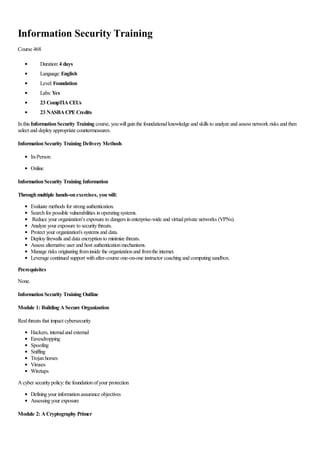information-security-training.pdf
- 1. Information Security Training Course 468 Duration:4 days Language:English Level:Foundation Labs:Yes 23 CompTIACEUs 23 NASBACPECredits Inthis InformationSecurity Training course, youwillgainthe foundationalknowledge and skills to analyze and assess network risks and then select and deployappropriate countermeasures. InformationSecurity Training Delivery Methods In-Person Online InformationSecurity Training Information Throughmultiple hands-onexercises, youwill: Evaluate methods for strongauthentication. Searchfor possible vulnerabilities inoperatingsystems. Reduce your organizationŌĆÖs exposure to dangers inenterprise-wide and virtualprivate networks (VPNs). Analyze your exposure to securitythreats. Protect your organization's systems and data. Deployfirewalls and data encryptionto minimize threats. Assess alternative user and host authenticationmechanisms. Manage risks originatingfrominside the organizationand fromthe internet. Leverage continued support withafter-course one-on-one instructor coachingand computingsandbox. Prerequisites None. InformationSecurity Training Outline Module 1: Building ASecure Organization Realthreats that impact cybersecurity Hackers, internaland external Eavesdropping Spoofing Sniffing Trojanhorses Viruses Wiretaps Acyber securitypolicy:the foundationofyour protection Definingyour informationassurance objectives Assessingyour exposure Module 2: ACryptography Primer
- 2. Securingdata withsymmetric encryption Choosingyour algorithm:DES, AES, Rc4, and others Assessingkeylengthand keydistribution Solvingkeydistributionissues withasymmetric encryption Generatingkeys EncryptingwithRSA Explore PGP and GnuPG EvaluatingWeb ofTrust and PKI Ensuringintegritywithhashes HashingwithMd5 and SHA Protectingdata intransit Buildingthe digitalsignature Module 3: Verifying UserandHost Identity Assessingtraditionalstatic password schemes Creatinga strongpassword policyto prevent password guessingand cracking Protectingagainst socialengineeringattacks Encryptingpasswords to mitigate the impact ofpassword sniffing Evaluatingstrongauthenticationmethods Preventingpassword replayusingone-time and tokenized passwords Employingbiometrics as part ofmulti-factor authentication Authenticatinghosts DistrustingIP (Internet Protocol) addresses Mitigatingaddress-spoofingissues and implementingcountermeasures Implementingsolutions for wireless networks Module 4: Preventing SystemIntrusions Discoveringsystemvulnerabilities Searchingfor operatingsystemvulnerabilities Discoveringfile permissionissues Limitingaccess via physicalsecurity Encryptingfiles for confidentiality Encryptingwithapplication-specific tools Recoveringencrypted data Hardeningthe operatingsystem Lockingdownuser accounts Securingadministrator's permissions Protectingagainst viruses Module 5: Guarding Against Network Intrusions Scanningfor vulnerabilities Searchingfor rogue servers Profilingsystems and services ReducingDenialofService (DoS) attacks
- 3. SecuringDNS (DomainName System) Limitingthe impact ofcommonattacks Deployingfirewalls to controlnetwork traffic Preventingintrusions withfilters Implementinga cyber securitypolicy Deployingpersonalfirewalls Protectingweb services and applications Validatinguser input Controllinginformationleakage Module 6: Ensuring Network Confidentiality Threats fromthe LAN Sniffingthe network Mitigatingthreats fromconnected hosts Partitioningthe network to prevent data leakage Identifyingwireless LAN vulnerabilities Confidentialityonexternalconnections Ensuringconfidentialitywithencryption SecuringcommunicationwithIPsec


